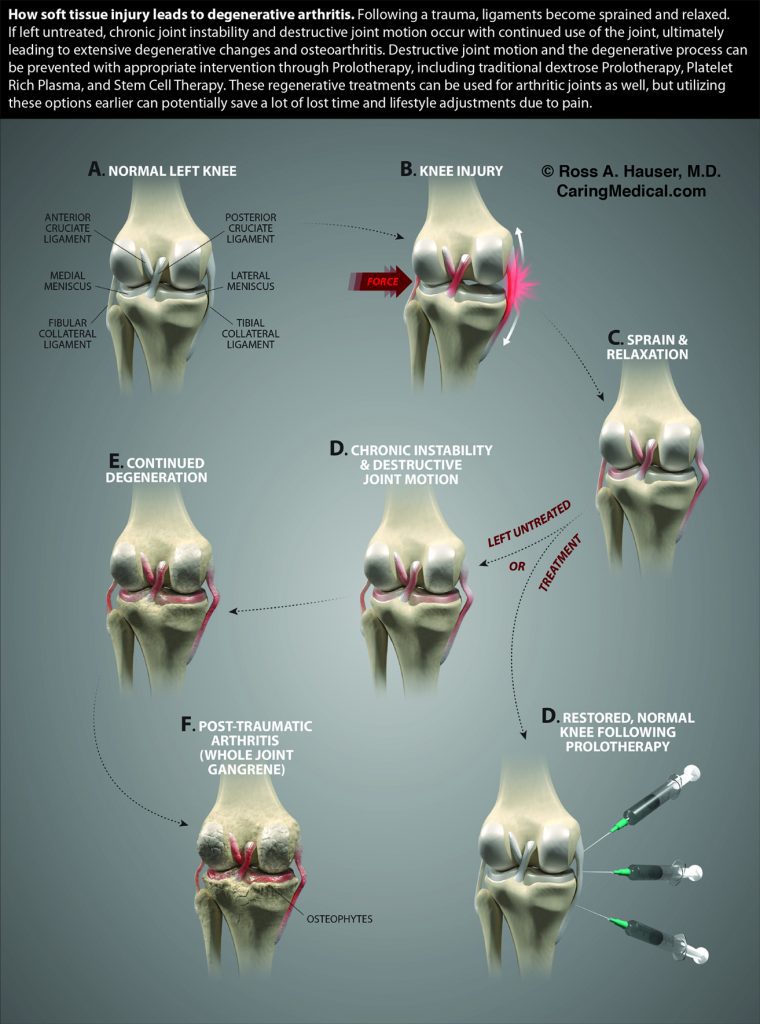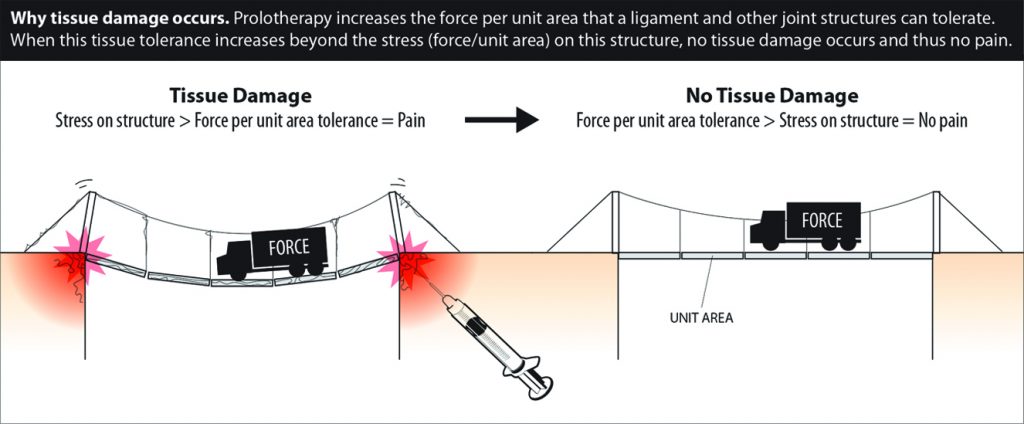By Debra K. Brinker, RN
Over 90% of athletic injuries involve stretched, torn or weakened soft tissue. Sports injuries, whether an ankle sprain, meniscal tear or rotator cuff tendonitis, occur when the repetitive strain of the athletic event is too much for a particular ligament, tendon, or muscle to perform. Regenerative medicine options can offer an advantageous treatment model over traditional pain management to repair soft tissue injuries and keep people active.
Unhealed sports injuries lead to arthritis
Acute trauma results in injury, but cumulative trauma over the years can also cause damage. Whether you are playing golf or tennis, riding your bike or running on the beach, the repetitive low-
grade impact from athletic events can be enough to damage the soft tissue structures. Degeneration can occur when these soft tissue injuries (non-healed injuries) are not fully addressed. (See figure 1.)


The development of arthritis can occur within a few years with severe injuries, or take decades to occur when the injury is less severe. Although progressive cartilage loss and inhibited joint motion plays a central role in osteoarthritis, injury to other soft tissue structures actually initiates the change in equilibrium that leads down the osteoarthritic path.
Ligaments are the key to maintaining joint integrity
Soft tissue structures such as cartilage, discs, labrum, ligaments, menisci and tendons are white and have a poor blood supply, unlike muscles which are red. Having a poor blood supply compromises the tissue’s ability to fully heal after injury. Ligaments are an integral white tissue component of the joint. (See figure 2.)


Unfortunately, ligament injuries are one of the most common causes of sport-related injuries. Ligament injury to the knee, for example, may give rise to jumper’s knee, meniscal tears, chondromalacia patella, bone spurs and osteoarthritis. Ligaments are a sensory organ with free nerve endings, generating pain when injured or stressed. Therefore, joint pain is an indication of tissue damage and should be taken seriously and addressed sooner rather than later.
When ligaments are injured, the harmony between the soft tissue, muscles and bony structures is disrupted, interfering with mobility and joint stability. The resultant joint instability then conveys abnormal forces throughout the joint, causing damage to other structures in and around the joint. When the ligaments are left untreated, the body will try to stabilize the joint by causing chronic muscle spasms, joint swelling and eventually bone spur formation and degenerative arthritis…a cycle of chronic pain. (See figure 3.)


Pitfalls of traditional sports medicine
Standard treatments for sports injuries involve symptom management utilizing nonsteroidal anti-
inflammatory drugs (NSAIDs), ice, immobilization, rest, or even cortisone injections to provide temporary pain relief. However, these methods can inhibit the healing process, making the athlete prone to re-injury in the future. When the athlete turns off the pain signal, especially with cortisone injections, and remains highly active on an injured joint, further cartilage and overall joint damage ensues. (See figure 4.)


It is important to realize that these treatment modalities do not repair soft tissue injuries nor do they regenerate cartilage. In fact, they accelerate cartilage degeneration!
Regenerative treatments restore joint integrity
The key to keeping joints strong is to stimulate the area to heal. Regenerative injection therapy does just that, offering greater opportunities for those suffering from sports injuries to stop the pain cycle and stay active safely. The treatments stimulate the repair of damaged ligaments and soft tissue. Non-
surgical regenerative therapies, including Prolotherapy, Platelet Rich Plasma (PRP), and Stem Cell Therapy, stimulate the natural regenerative processes in and around the joint and facilitate the restoration of the degenerated soft tissue to a healthy state, improving joint support and function, and reducing pain and symptoms. (See figure 5.)


Dextrose Prolotherapy elicits localized inflammation, stimulating the normal healing process. Biocellular therapies (PRP and stem cells) may be added to enhance the effects of dextrose Prolotherapy, especially in those with severe injuries or in advanced osteoarthritic conditions. These treatments involve the injection of an autologous preparation, from a person’s own plasma, fat or bone marrow, injected directly into the damaged joint to accelerate the healing process.
Sports injuries do not need to put an end to the enjoyment of sports activities. Regenerative injection therapy is a great non-surgical treatment offering not only pain relief from sports injuries, but healing at the source. This regeneration and repair enables the athlete of all ages to speedily return to the sport or activity they love with minimal lifestyle interruption.
Regenerative Medicine Specialists
CaringMedical.com
239-303-4546
with locations in Fort Myers and Chicagoland
. Stem Cell Therapy . Prolotherapy . Platelet Rich Plasma
 Southwest Florida's Health and Wellness Magazine Health and Wellness Articles
Southwest Florida's Health and Wellness Magazine Health and Wellness Articles

